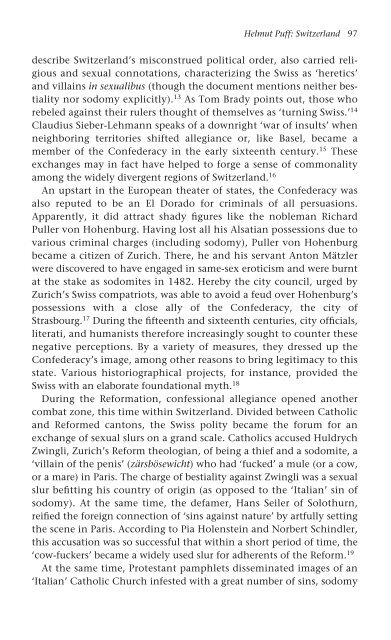queer masculinities
queer masculinities
queer masculinities
You also want an ePaper? Increase the reach of your titles
YUMPU automatically turns print PDFs into web optimized ePapers that Google loves.
Helmut Puff: Switzerland 97<br />
describe Switzerland’s misconstrued political order, also carried religious<br />
and sexual connotations, characterizing the Swiss as ‘heretics’<br />
and villains in sexualibus (though the document mentions neither bestiality<br />
nor sodomy explicitly). 13 As Tom Brady points out, those who<br />
rebeled against their rulers thought of themselves as ‘turning Swiss.’ 14<br />
Claudius Sieber-Lehmann speaks of a downright ‘war of insults’ when<br />
neighboring territories shifted allegiance or, like Basel, became a<br />
member of the Confederacy in the early sixteenth century. 15 These<br />
exchanges may in fact have helped to forge a sense of commonality<br />
among the widely divergent regions of Switzerland. 16<br />
An upstart in the European theater of states, the Confederacy was<br />
also reputed to be an El Dorado for criminals of all persuasions.<br />
Apparently, it did attract shady figures like the nobleman Richard<br />
Puller von Hohenburg. Having lost all his Alsatian possessions due to<br />
various criminal charges (including sodomy), Puller von Hohenburg<br />
became a citizen of Zurich. There, he and his servant Anton Mätzler<br />
were discovered to have engaged in same-sex eroticism and were burnt<br />
at the stake as sodomites in 1482. Hereby the city council, urged by<br />
Zurich’s Swiss compatriots, was able to avoid a feud over Hohenburg’s<br />
possessions with a close ally of the Confederacy, the city of<br />
Strasbourg. 17 During the fifteenth and sixteenth centuries, city officials,<br />
literati, and humanists therefore increasingly sought to counter these<br />
negative perceptions. By a variety of measures, they dressed up the<br />
Confederacy’s image, among other reasons to bring legitimacy to this<br />
state. Various historiographical projects, for instance, provided the<br />
Swiss with an elaborate foundational myth. 18<br />
During the Reformation, confessional allegiance opened another<br />
combat zone, this time within Switzerland. Divided between Catholic<br />
and Reformed cantons, the Swiss polity became the forum for an<br />
exchange of sexual slurs on a grand scale. Catholics accused Huldrych<br />
Zwingli, Zurich’s Reform theologian, of being a thief and a sodomite, a<br />
‘villain of the penis’ (zärsbösewicht) who had ‘fucked’ a mule (or a cow,<br />
or a mare) in Paris. The charge of bestiality against Zwingli was a sexual<br />
slur befitting his country of origin (as opposed to the ‘Italian’ sin of<br />
sodomy). At the same time, the defamer, Hans Seiler of Solothurn,<br />
reified the foreign connection of ‘sins against nature’ by artfully setting<br />
the scene in Paris. According to Pia Holenstein and Norbert Schindler,<br />
this accusation was so successful that within a short period of time, the<br />
‘cow-fuckers’ became a widely used slur for adherents of the Reform. 19<br />
At the same time, Protestant pamphlets disseminated images of an<br />
‘Italian’ Catholic Church infested with a great number of sins, sodomy


